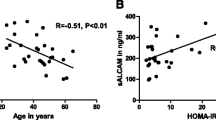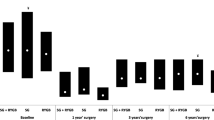Abstract
Background
Decrease of both visceral fat (surgery, physical exercise) and subcutaneous fat (liposuction) is accompanied by improvement of insulin sensitivity.
Methods
In this study, metabolic variables (glucose, insulin, high-density lipoprotein–cholesterol, triglycerides, aspartate aminotransferase, alanine aminotransferase, uric acid, ferritin) and adhesion molecules (ICAM-1, entothelin-1, E-selectin) were determined in 126 morbidly obese subjects before and 1 year after bariatric restrictive surgery (laparoscopic gastric banding) and correlated with anthropometric measures, i.e., body mass index (BMI) and waist circumference (waist), and with echographic measures of thickness of visceral (usVT) and subcutaneous (usST) abdominal fat.
Results
Under basal conditions and after 1 year, metabolic variables correlated with BMI and waist (r from 0.157 to 0.507, p from 0.0182 to 0.0001) and with usVT (r from 0.211 to 0.512, p from 0.05 to 0.0001); insulin also correlated with usST, and adhesion molecules only correlated with BMI and usVT (r from 0.341 to 0.502, p from 0.0066 to 0.0001). Changes of metabolic variables correlated with changes of BMI and waist (r from 0.163 to 0.356, p from 0.0328 to 0.0001) and with usVT changes (r from 0.211 to 0.361, p from 0.0339 to 0.0002); changes of adhesion molecules only correlated with BMI and usVT changes (r from 0.227 to 0.361, p from 0.0444 to 0.0108). Changes of metabolic variables and of adhesion molecules virtually never correlated with changes of usST.
Conclusion
These data indicate that in morbid obesity, most metabolic abnormalities are associated with visceral fat and that their improvements after weight loss are associated with decrease of visceral fat.
Similar content being viewed by others
References
Vague J. The degree of masculine differentiation of obesities; a factor determining predispositions to diabetes, atherosclerosis, gout and uric calculous disease. Am J Clin Nutr 1956;4:20–34.
Jensen MD. Is visceral fat involved in the pathogenesis of metabolic syndrome? Human model. Obesity 2006;14(Suppl):20S–24S.
Rossner S, Bo WJ, Hiltbrandt E. Adipose tissue determinations in cadavers—a comparison between cross-sectional planimetry and computed tomography. Int J Obes 1990;14:893–902.
Armellini F, Zamboni M, Robbi R. Total and intra-abdominal fat measurements by ultrasound and computerized tomography. Int J Obes 1993;17:209–14.
Terry JG, Hinson WH, Evans GW, Schreiner PJ, Hagaman AP, Crouse JR 3rd. Evaluation of magnetic resonance imaging for quantification of intraabdominal fat in human beings by spin-echo and inversion-recovery protocols. Am J Clin Nutr 1995;62(2):297–301.
Fantuzzi G, Mazzone T. Adipose tissue and atherosclerosis. Exploring the connection. Arterioscl Thromb Vasc Biol 2007;27:996–1003.
Boyko EJ, Leonetti DL, Bergstrom RW, Newell-Morris L, Fujimoto WY. Visceral adiposity, fasting plasma insulin, and blood pressure in Japanese-Americans. Diabetes Care 1995;18:174–81.
Ziccardi P, Nappo F, Giugliano G, Esposito K, Marfella R, Cioffi M, et al. Reduction of inflammatory cytokine concentrations and improvement of endothelial functions in obese women after weight loss over one year. Circulation 2002;105:804–9.
Vohl MC, Sladek R, Robitaille J, Gurd S, Marceau P, Richard D, et al. A survey of genes differentially expressed in subcutaneous and visceral adipose tissue in men. Obes Res 2004;12:1217–22.
Bruun JM, Lihn AS, Madan AK, Pedersen SB, Schiøtt KM, Fain JN, et al. Higher production of IL-8 in visceral vs. subcutaneous adipose tissue. Implication of nonadipose cells in adipose tissue. Am J Physiol Endocrinol Metab 2004;286:E8–E13.
Fain JN, Madan AK, Hiler ML, Cheema P, Bahouth SW. Comparison of the release of adipokines by adipose tissue, adipose tissue matrix, and adipocytes from visceral and subcutaneous abdominal adipose tissues of obese humans. Endocrinology 2004;145:2273–82.
Pitombo C, Araújo EP, De Souza CT, Pareja JC, Geloneze B, Velloso LA. Amelioration of diet-induced diabetes mellitus by removal of visceral fat. J Endocrinol 2006;191:699–706.
Gabriely I, Ma XH, Yang XM, Atzmon G, Rajala MW, Berg AH, et al. Removal of visceral fat prevents insulin resistance and glucose intolerance of aging: an adipokine-mediated process? Diabetes 2002;51:2951–8.
Thörne A, Lönnqvist F, Apelman J, Hellers G, Arner P. A pilot study of long-term effects of a novel obesity treatment: omentectomy in connection with adjustable gastric banding. Int J Obes Relat Metab Disord 2002;26:193–9.
Tran TT, Yamamoto Y, Gesta S, Kahn CR. Transplantation of subcutaneous fat to the visceral cavity induced protective metabolic effects; evidence for intrinsic properties of subcutaneous fat. Diabetes 2007;56(suppl):A5. (abstract).
Pontiroli AE, Pizzocri P, Librenti MC, Vedani P, Marchi M, Cucchi E, et al. Laparoscopic adjustable gastric banding for the treatment of morbid (grade 3) obesity and its metabolic complications: a three-year study. J Clin Endocrinol Metab 2002;87:3555–61.
O’Leary VB, Marchetti CM, Krishnan RK, Stetzer BP, Gonzalez F, Kirwan JP. Exercise-induced reversal of insulin resistance in obese elderly is associated with reduced visceral fat. J Appl Physiol 2006;100:1584–9.
Hanusch-Enserer U, Cauza E, Spak M, Endler G, Dunky A, Tura A, et al. Improvement of insulin resistance and early atherosclerosis in patients after gastric banding. Obes Res 2004;12:284–91.
Pontiroli AE, Pizzocri P, Koprivec D, Vedani P, Marchi M, Arcelloni C, et al. Body weight and glucose metabolism have a different effect on circulating levels of ICAM-1, E-selectin, and endothelin-1 in humans. Eur J Endocrinol 2004;150:195–200.
Pontiroli AE, Pizzocri P, Paroni R, Folli F. Sympathetic overactivity, endothelial dysfunction, inflammation, and metabolic abnormalities cluster in grade III (World Health Organization) obesity: reversal through sustained weight loss obtained with laparoscopic adjustable gastric banding. Diabetes Care 2006;29:2735–8.
Esposito K, Giugliano G, Scuderi N, Giugliano D. Role of adipokines in the obesity-inflammation relationship: the effect of fat removal. Plast Reconstr Surg 2006;118:1048–57.
Klein S, Fontana L, Young VL, Coggan AR, Kilo C, Patterson BW, et al. Absence of an effect of liposuction on insulin action and risk factors for coronary heart disease. N Engl J Med 2004;350:2549–57.
Pontiroli AE, Pizzocri P, Giacomelli M, Marchi M, Vedani P, Cucchi E, et al. Ultrasound measurement of visceral and subcutaneous fat in morbidly obese patients before and after laparoscopic adjustable gastric banding: comparison with computerized tomography and with anthropometric measurements. Obes Surg 2002;12:648–51.
Ford ES, Giles WH, Dietz WH. Prevalence of the metabolic syndrome among US adults: findings from the third National Health and Nutrition Examination Survey. JAMA 2002;287:356–9.
le Roux CW, Aylwin SJ, Batterham RL, Borg CM, Coyle F, Prasad V, et al. Gut hormone profiles following bariatric surgery favor an anorectic state, facilitate weight loss, and improve metabolic parameters. Ann Surg 2006;243:108–4.
Guidone C, Manco M, Valera-Mora E, Iaconelli A, Gniuli D, Mari A, et al. Mechanisms of recovery from type 2 diabetes after malabsorptive bariatric surgery. Diabetes 2006;55:2025–31.
de Alwis NM, Day CP. Non-alcoholic fatty liver disease: the mist gradually clears. J Hepatol 2008;48(Suppl 1):S104–S112.
Acknowledgments
This work was supported by Grant FIRST 2006 from Universita’ degli Studi di Milano.
Disclosures
The authors of this manuscript have no potential conflicts of interest.
Author information
Authors and Affiliations
Corresponding author
Rights and permissions
About this article
Cite this article
Pontiroli, A.E., Frigè, F., Paganelli, M. et al. In Morbid Obesity, Metabolic Abnormalities and Adhesion Molecules Correlate with Visceral Fat, Not with Subcutaneous Fat: Effect of Weight Loss Through Surgery. OBES SURG 19, 745–750 (2009). https://doi.org/10.1007/s11695-008-9626-4
Received:
Accepted:
Published:
Issue Date:
DOI: https://doi.org/10.1007/s11695-008-9626-4




